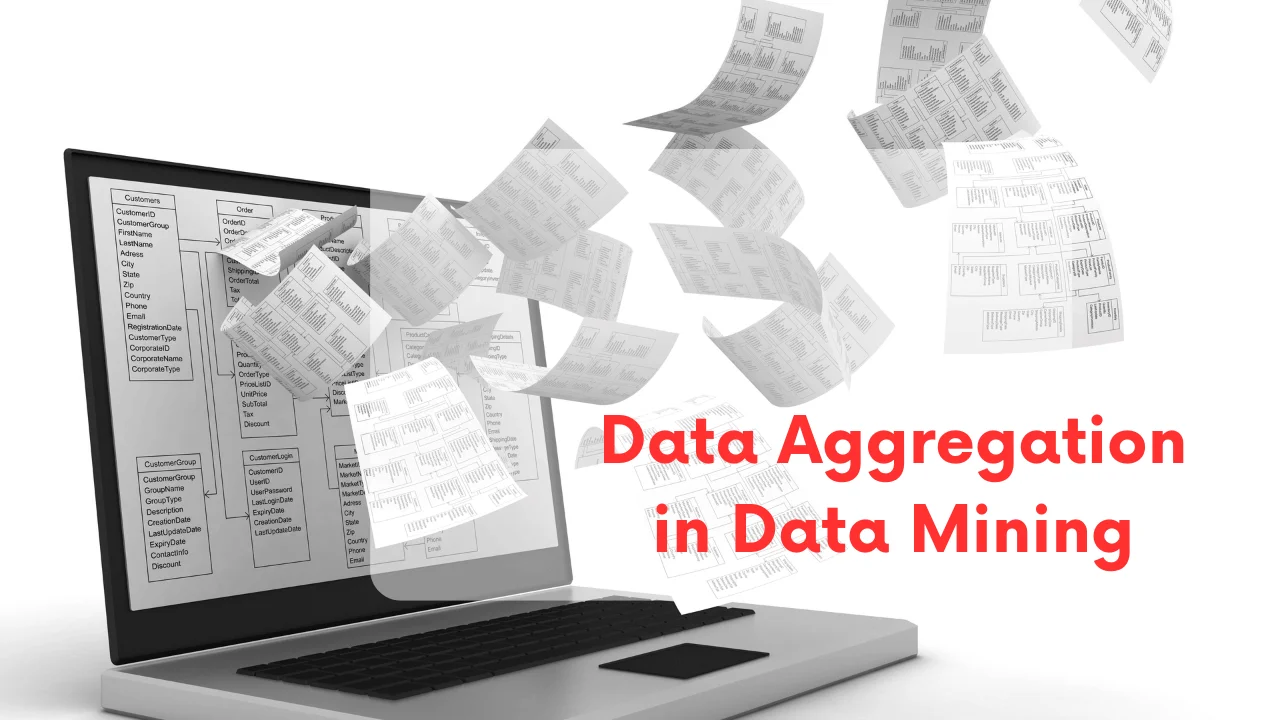Introduction
Compiling and summarizing data to enable insightful analysis is known as data aggregation in data mining. It is a transformative process. Analysts are able to spot trends, patterns, and outliers in huge datasets because it facilitates the better management of enormous amounts of raw data. Data is reduced to more manageable forms through operations like summarization, averaging, and grouping. Data aggregation is an essential part of data mining because it reduces noise and highlights the most relevant information, making subsequent analyses more efficient and effective. Its significance is highlighted in industries such as healthcare, retail, marketing, and finance, where decision-makers rely on actionable insights obtained from aggregated data.
Importance of Data Aggregation in Data Mining

In order to extract useful information from large datasets, data aggregation is an essential component of data mining. Let’s take a closer look at its importance:
Streamlining Data for Analysis
Data that has been aggregated makes complex datasets easier to understand. It simplifies data by summarizing large amounts of information, which makes it easier for analysts to focus on important patterns and trends.
Machine Learning Models
Preparation is key for machine learning models. Machine learning algorithms are able to make more accurate predictions when data is aggregated because it helps to lower the dataset’s noise and highlight important features.
Supporting Business Intelligence
Business intelligence relies on aggregated data to help decision-makers comprehend operational performance, consumer trends, and market tendencies. Better decisions that are in line with the goals of the organization are the result of this.
Reducing Data Volume for Processing
Data mining is made faster with aggregated data because less data needs to be processed. For situations requiring efficient processing of massive amounts of data, this is of the utmost importance.
Facilitating Cross-Industry
In order to discover important insights that drive efficiency and innovation, data aggregation is used in many different industries, including healthcare and finance.
Techniques

Various methods for data aggregation are employed to convert raw data into valuable insights:
Summarization
Finding important patterns in data and then condensing them into a concise representation is what summarization is all about. This method is great for getting a feel for general tendencies because it summarizes datasets.
Grouping
Data can be “grouped” by arranging it into sets defined by shared characteristics. This method finds extensive application in consumer segmentation due to its usefulness in identifying patterns within various data subsets.
Averaging
The central tendency can be better understood by calculating the mean values across data sets using averaging. To learn about patterns or common occurrences in a dataset, it is helpful.
Frequency Analysis
Counting the occurrences of particular values within the dataset is the main focus of frequency analysis. Common behaviors or recurring events can be better understood with the help of this method.
Benefits
There are many advantages to data mining that result from the strategic use of data aggregation:
Enhanced Decision-Making
Better, more strategic decisions are made possible with the help of aggregated data, which gives decision-makers a bird’s-eye view of critical metrics.
Improved Data Quality
Data aggregation is a useful tool for improving the quality of data used for analysis by filtering out irrelevant and noisy data.
Increased Analytical Efficiency
Fewer data points mean less time and fewer resources needed for analysis, which means quicker insights.
Scalable Solutions
Scalable data mining solutions are made possible through data aggregation, allowing for efficient handling of large-scale datasets.
Better Predictive Modeling
Forecasting and other predictive analytics applications rely on aggregated data to build more accurate predictive models.
Challenges
Data aggregation has many benefits, but it also has some drawbacks:
Particularly in cases where minute details are important, data loss can occur as a result of aggregation.
Scalability Issues
Computing intensive processing of massive datasets for aggregation presents scalability issues.
Complexity in Aggregation Rules
Determining suitable aggregation rules that remove noise while capturing data’s essential features is a challenging undertaking.
Maintaining Data Integrity
Careful handling is required to avoid inaccuracies or misrepresentation and ensure data integrity during aggregation.
Dynamic Data Environments
It might be difficult to keep the aggregated data up-to-date in environments where data is constantly changing.
Data Aggregation for Machine Learning Models
Machine learning models rely heavily on data aggregation:
Feature Selection
In order to improve the predictive accuracy of machine learning models, aggregated data is useful for selecting the most relevant features. Dealing with The ability to manage large datasets is fundamental to big data analytics, and big data aggregation techniques make this possible.
Reducing Noise
Machine learning datasets benefit from aggregated data because it lowers noise levels, allowing models to learn from cleaner data.
Improving Model Interpretability
By offering a consolidated view of key characteristics, aggregated data improves machine learning models’ interpretability. Data aggregation helps with model training by lowering the dimensionality of the dataset, which in turn lowers the computational overhead.
Applications
Because of its capacity to transform raw data into valuable insights, data aggregation finds varied uses across industries. Among the many important uses are:
Retail Customer Analytics Trends, preferences, and buying habits can be better understood with the use of aggregated consumer data. Companies can increase sales, customer happiness, and product customization by analyzing this data.
Financial Forecasting
Investment strategies, risk assessments, and market trend forecasts can all benefit from aggregated data in the financial sector. Reports that shed light on financial health and predict future trends rely heavily on aggregation.
Healthcare Analytics
Healthcare providers can detect health trends, track disease outbreaks, and enhance patient care strategies with the help of aggregated patient data. As a result, healthcare delivery is made more efficient and resources are better allocated.
Telecommunications Analytics
Aggregated data is crucial for telecoms to comprehend client usage trends, enhance service quality, and optimize network performance. Predicting demand and improving the user experience are both helped by data aggregation.
Manufacturing Process Optimization
In order to optimize production workflows, decrease waste, and find inefficiencies, aggregated data from manufacturing processes is useful. Overall operational efficiency is improved, and predictive maintenance is bolstered.
Tools
In order to efficiently gather data, numerous tools have been created, each with its own set of advantages:
ETL (Extract, Transform, Load) Tools
Ideal for merging data from various sources, ETL tools automate data extraction, transformation, and loading. Apache Airflow, Apache Talend, and Apache Nifi are three of the most well-known ETL tools.
Data Warehousing Solutions
Data warehouses, like Google BigQuery and Amazon Redshift, allow businesses to organize and store aggregated data for future analysis. Enterprise analytics that involve large-scale data aggregation can be supported by these.
Business Intelligence Platforms
Tableau, Qlik, and Power BI are a few examples of business intelligence platforms that have tools for data visualization and aggregation. Platforms like these make data summarization and insight generation much easier.
Libraries
Python packages like Pandas provide developers with a wealth of tools for data aggregation. Data aggregation in bespoke data processing workflows relies heavily on these libraries.
Frameworks
Scalable data aggregation across distributed systems is made possible by frameworks such as Apache Spark and Apache Flink. These are absolutely necessary for dealing with massive datasets in real-time.
Best Practices for Data Mining Projects
It is critical to adhere to data aggregation best practices in order to attain optimal results:
Define Clear Objectives
Make sure you’re collecting and summarizing the right data for analysis by clearly defining the goals of data aggregation.
Ensure Data Quality
It is important to use clean, consistent, and comprehensive data when aggregating. To make sure the data is accurate, run cleansing procedures on it before aggregation.
Select Appropriate Aggregation Methods
Make sure the aggregation methods you choose are in line with the analysis’s goals. Consider the type of data before deciding whether to use averaging or summing as a method.
Maintain Data Privacy
Take precautions to protect privacy and stay in line with privacy regulations such as GDPR and CCPA when you combine sensitive data.
Regularly Update Aggregated Data
Make sure that aggregated data is updated frequently in dynamic environments so that it reflects real-time changes and remains accurate.
FAQs
What is data aggregation in data mining?
Data aggregation involves compiling and summarizing data to enable efficient analysis in data mining.
Why is data aggregation important in data mining?
It enhances the efficiency of data analysis by reducing noise and focusing on the most relevant information.
How does data aggregation improve machine learning models?
Aggregated data improves machine learning models by providing clean and relevant datasets for training, enhancing model accuracy.
What are the challenges in data aggregation in data mining?
Challenges include data loss, scalability issues, and ensuring data integrity.
Which tools are commonly used for data aggregation in data mining?
Common tools include ETL tools, data warehouses, business intelligence platforms, and data aggregation libraries like Pandas.
Also Read: Data Mining Primitives: Explained In Detail
Conclusion
Finally, Data Aggregation in Data Mining step is critical for turning massive amounts of raw data into useful insights. In order to find useful patterns in the data, analysts use tools like summarization, grouping, averaging, and summing. Data integrity and scalability aren’t without their problems, but the payoff in terms of better analytics, more accurate predictions, and more effective decision-making is substantial. Business intelligence and machine learning rely heavily on aggregated data, which lays the groundwork for data-driven decision-making in all kinds of sectors.

Brandy Stewart, an enchanting wordsmith and seasoned blogger, weaves compelling narratives that transport readers to uncharted territories. Infused with perceptive viewpoints and dynamic storytelling, Doris exhibits a command of language that enthralls both hearts and minds, leaving a lasting mark on the literary panorama.

